
V Corps, formerly known as the Fifth Corps, is a regular corps of the United States Army headquartered at Fort Knox, Kentucky and Camp Kościuszko, Poland.

The Supreme Headquarters Allied Powers Europe (SHAPE) is the military headquarters of the North Atlantic Treaty Organization's (NATO) Allied Command Operations (ACO) that commands all NATO operations worldwide. SHAPE is situated in the village of Casteau, near Mons, Belgium.
An army group is a military organization consisting of several field armies, which is self-sufficient for indefinite periods. It is usually responsible for a particular geographic area. An army group is the largest field organization handled by a single commander – usually a full general or field marshal – and it generally includes between 400,000 and 1,000,000 soldiers.
The Allied Rapid Reaction Corps (ARRC) is a rapid reaction force maintained by NATO. It is capable of deploying a High Readiness Force (Land) Headquarters at short notice for operations and crisis response.

Allied Joint Force Command Brunssum (JFCBS) is a NATO command with its headquarters at Brunssum, the Netherlands. It was established in 2004, as part of a reorganisation that reduced the number of NATO Military Command Structure headquarters.
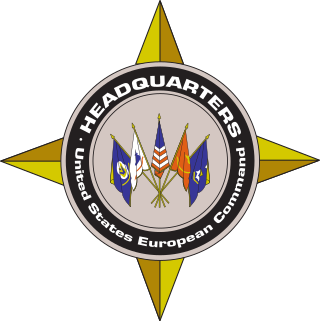
The United States European Command (EUCOM) is one of the eleven unified combatant commands of the United States military, headquartered in Stuttgart, Germany. Its area of focus covers 21,000,000 square miles (54,000,000 km2) and 51 countries and territories, including Europe, The Caucasus, Russia and Greenland. The Commander of the United States EUCOM simultaneously serves as the Supreme Allied Commander, Europe (SACEUR) within NATO, a military alliance. During the Gulf War and Operation Northern Watch, EUCOM controlled the forces flying from Incirlik Air Base.

Campbell Barracks, in Heidelberg, Germany, was home to Headquarters, United States Army Europe (USAREUR) from 1948 to 2013. It was also home to Headquarters, V Corps and Headquarters, Allied Force Command Heidelberg.

The Joint Force CommandNaples is a NATO military command based in Lago Patria, in the Metropolitan City of Naples, Italy. It was activated on 15 March 2004, after effectively redesigning its predecessor command, Allied Forces Southern Europe (AFSOUTH), originally formed in 1951. In NATO Military Command Structure terms, AFSOUTH was a "Major Subordinate Command". The commander of JFC Naples reports to the Supreme Allied Commander Europe at the Supreme Headquarters Allied Powers Europe, Casteau, Belgium.

The Allied Air Command (AIRCOM) is the central command of all NATO air and space forces and the Commander Allied Air Command is the prime air and space advisor to the Alliance. When directed by the Supreme Allied Commander Europe (SACEUR), it provides the core of the headquarters responsible for the conduct of air operations. The command is based at the Ramstein Air Base in Germany.

The Multinational Corps Northeast was formed on 18 September 1999 at Szczecin, Poland, which became its headquarters. It evolved from what was for many years the only multinational corps in NATO, Allied Land Forces Schleswig-Holstein and Jutland (LANDJUT). From 1962 LANDJUT had been responsible for the defence of the Baltic Approaches from a headquarters at Rendsburg, Germany. It comprised the 6th Panzergrenadier Division and the Danish Jutland Division.
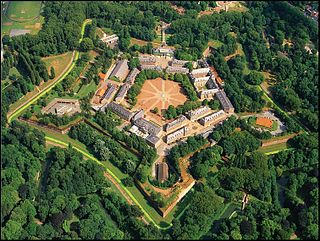
The Rapid Reaction Corps — France (RRC-FR) was created on 1 July 2005 by the French Army. It is NATO certified and capable of commanding a national or multinational land component of between 5,000 and 60,000 personnel. Plans call for the corps to command forces under French, EU or NATO command. It is subordinated to the French Army's Land Forces Command (CFT).
1 German-Netherlands Corps (1GNC) is a multinational formation consisting of units from both the Royal Netherlands Army and German Army. The corps' headquarters also takes part in NATO Response Force readiness rotations. It is situated in Münster, formerly the headquarters of the German Army's I. Corps out of which 1 German-Netherlands Corps evolved. The corps has national and multinational operational responsibilities.
The Structure of the North Atlantic Treaty Organization is complex and multi-faceted. The decision-making body is the North Atlantic Council (NAC), and the member state representatives also sit on the Defence Policy and Planning Committee (DPPC) and the Nuclear Planning Group (NPG). Below that the Secretary General of NATO directs the civilian International Staff, that is divided into administrative divisions, offices and other organizations. Also responsible to the NAC, DPPC, and NPG are a host of committees that supervise the various NATO logistics and standardisation agencies.
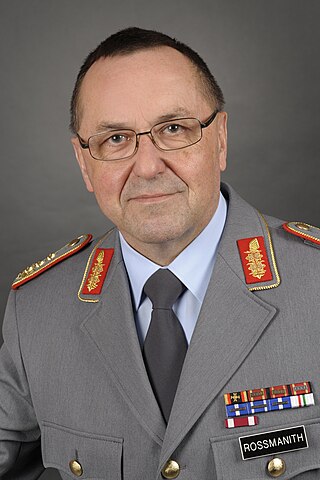
Lieutenant General Richard Rossmanith is a German Army officer and currently Commander of the Multinational Joint Headquarters Ulm in Ulm, Germany.
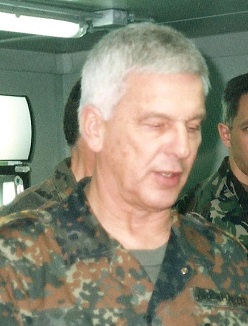
Klaus Reinhardt was a German Army general. He was the commander of the German Army Forces Command, the NATO Joint Headquarters Center, and KFOR in Kosovo. Reinhardt died on 30 November 2021, at the age of 80. He was the son of Nazi bureaucrat Fritz Reinhardt.

Allied Air Forces Central Europe (AAFCE) was the NATO command tasked with air and air defense operations in NATOs Allied Forces Central Europe (AFCENT) area of command.
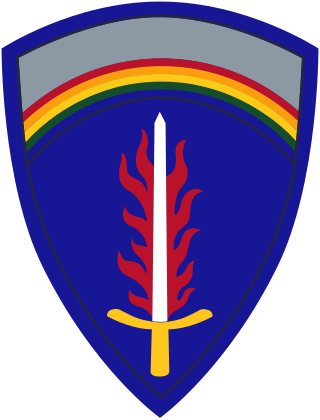
United States Army Europe and Africa (USAREUR-AF) is an Army Service Component Command (ASCC) /Theater Army responsible for directing United States Army operations throughout the U.S. European Command (EUCOM) and U.S. Africa Command (AFRICOM) area of responsibility.

The Allied Land Command (LANDCOM) formerly Allied Land Forces South-Eastern Europe (LANDSOUTHEAST) is the standing headquarters for NATO land forces which may be assigned as necessary. The Commander LANDCOM is the primary land warfare advisor to Supreme Allied Commander Europe (SACEUR) and the Alliance. When directed by SACEUR, it provides the core of the headquarters responsible for the conduct of land operations. The command is based at Şirinyer (Buca), İzmir in Turkey.

General Hans-Lothar Domröse is a senior German Army officer, former Commander of Allied Joint Force Command Brunssum.

The United States Army NATO Brigade (USANATO) is a US Army brigade providing training, logistics, human resources, and service-specific support at 81 US Army NATO locations across 21 countries. The brigade headquarters is based in Sembach in Germany.

















